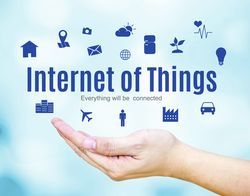Marketing & The Internet of Things: Radio Q&A with Author Rick Mathieson
 Is 2016 the year marketing and the Internet of Things finally enter a meaningful new phase?
Is 2016 the year marketing and the Internet of Things finally enter a meaningful new phase?
Don't bet on it. But there are some promising signs.
In the days since CES, much has been made of the emergence of new ecosystems enabled by so-called "smart products"���connected devices that deliver information, or enable you to say, control or interact with them using your mobile phone.
Fitness apparel brand Under Armour was one entrant that generated a lot of attention during the show for its new Gemini 2 running shoes, which can track run duration, distance and more���without the need for syncing with a mobile device.
It's just the latest in innovative smart products UA has been rolling out, including a heart-rate monitor, new headphones and apps that, as Engadget reports today, the company hopes to use as the foundation for an interconnected ecosystem.
Indeed, while Engadget indicates these products have a ways to go, they may still point toward fitness apparel that doesn't just keep you comfortable, but provides useful services for you automatically and seamlessly, behind the scenes, to help you attain your goals.
From Data Collection to Data Utility
Last week, Social Times cited a report from the Economist Intelligence Unit that finds 51% of marketing executives expect the Internet of Things���or "IoT"���"to revolutionize marketing by 2020."
In the view of the Times at least, the first phase of marketing's embrace of the IoT will be what we experience today: Devices that collect data on usage patterns, facilitating new offers based on needs, or helping developers improve the products.
In Phase 2, says Social Times, brands will open up the their ecosystems to other advertisers. Think refrigerators that don't just send you alerts that you're almost out of milk, but also let Tropicana send you a coupon for Orange Juice.
It's hard to imagine the Times can possibly be wrong about that. Some brands will indeed attempt such things���it would be crazy to not at least try to monetize that ecosystem beyond the purchase of the device itself.
It remains to be seen, however, whether consumers will really cotton to a barrage of offers coming from their fridge, their toaster, their washing machine and so on. I'm personally skeptical many people want an ad supported home appliance���the equivalent of a promotional announcement that "this refrigeration is brought to you by Heinz Ketchup," for instance.
Product Plus
Instead, as I write in my book, THE ON-DEMAND BRAND, the ecosystems enabled by the IoT likely represent something far more compelling than applying ad models from one medium���essentially banner ads or mobile coupons���to a whole new one (in this case your home appliances) merely to eke out some additional revenue.
While ad models will no-doubt be explored, ultimately brands will keep these ecosystems to themselves, finding that advertising only cheapens what may be their only point of differentiation in a world where physical products themselves are increasingly commoditized.
"In the digital age, differentiation may come less from the quality with which your products are manufactured, and more from the on-demand digital services they deliver to your customers." I write.
And I'm not just talking about household appliances, by the way. I'm talking about everything from those Gemini 2 running shoes to your breakfast cereal, to your kids' toys, to your laundry detergent.
Smart brands will focus on delivering truly useful services via these connected ecosystems. Not the kind that throws coupons at you. Rather, the kind that adds immediate value���Lean Cuisine frozen dinners that tell the microwave how to cook them to perfection, for instance���or helps you accomplish new goals or provide new services, like say, real-time smoking cessation support from Chantix, triggered by sensors built into a wristband.
Perhaps some of these services will prove valuable enough to warrant both freemium and premium subscription models���turning products sold once into ongoing revenue streams.
In a recent radio segment with Forbes Radio's "Jim Blasingame Show," I talk about this emerging trend as one of three that will start to gain traction in 2016.
Do note that this particular program is aimed at SMBs, so I talk about the trend overall, and then address how smaller brands and local stores can leverage existing technologies to avoid being Amazoned by the likes of, well, Amazon and its Dash devices.
Which, like those Gemini 2 running shoes, are perfect early examples of products-as-services enabled by an IoT in which many of even the earliest offerings provide tremendous value without requiring a digital interface at all.
CLICK TO LISTEN���TREND WATCH: (PRODUCTS ARE THE NEW SERVICES"
Or follow this link: http://ow.ly/Xo7OP
(Approximately 4 minutes, 14 seconds)
NEW: JOIN OUR LINKEDIN GROUP
Like us on Facebook
Follow us on Twitter
Listen in on iTunes
Rick Mathieson's Blog
- Rick Mathieson's profile
- 1 follower



